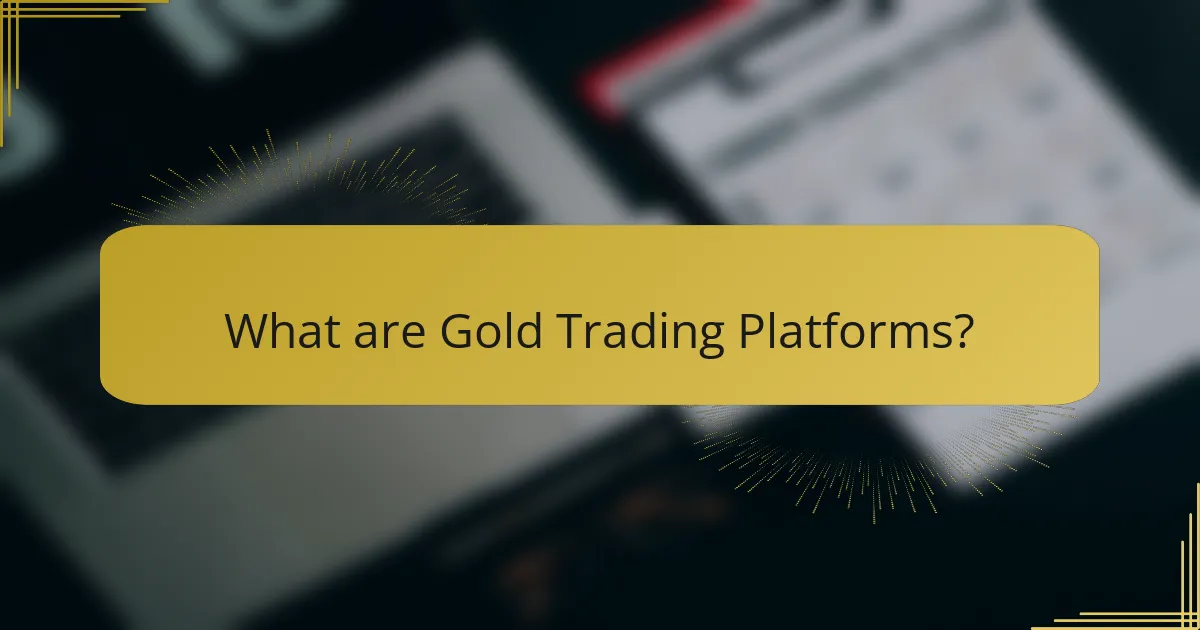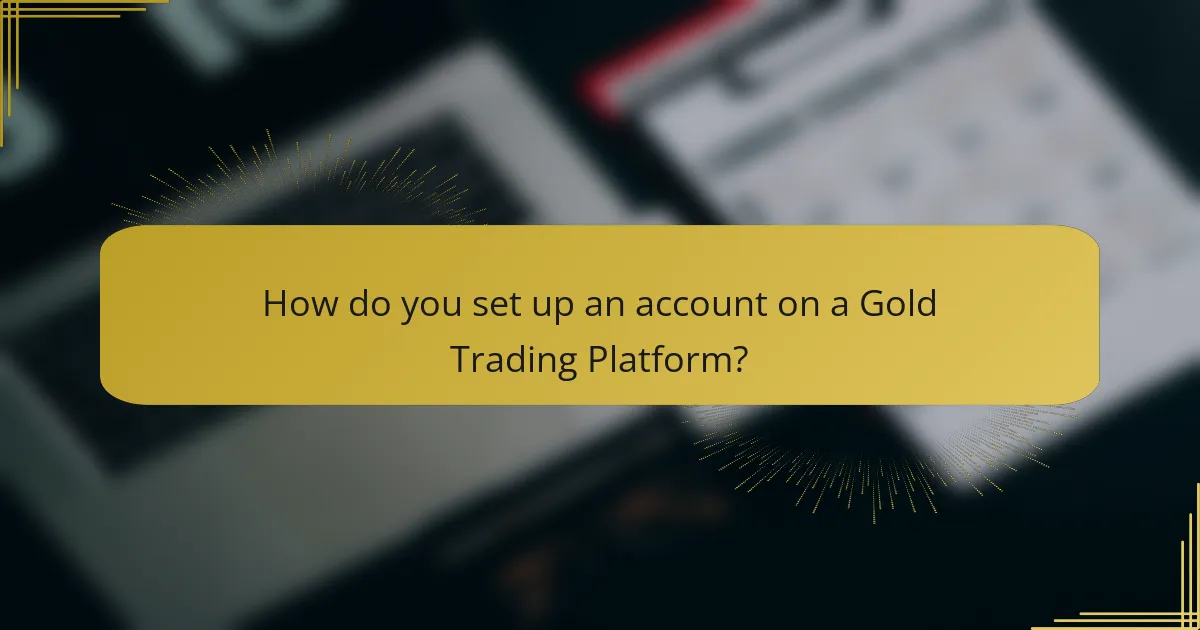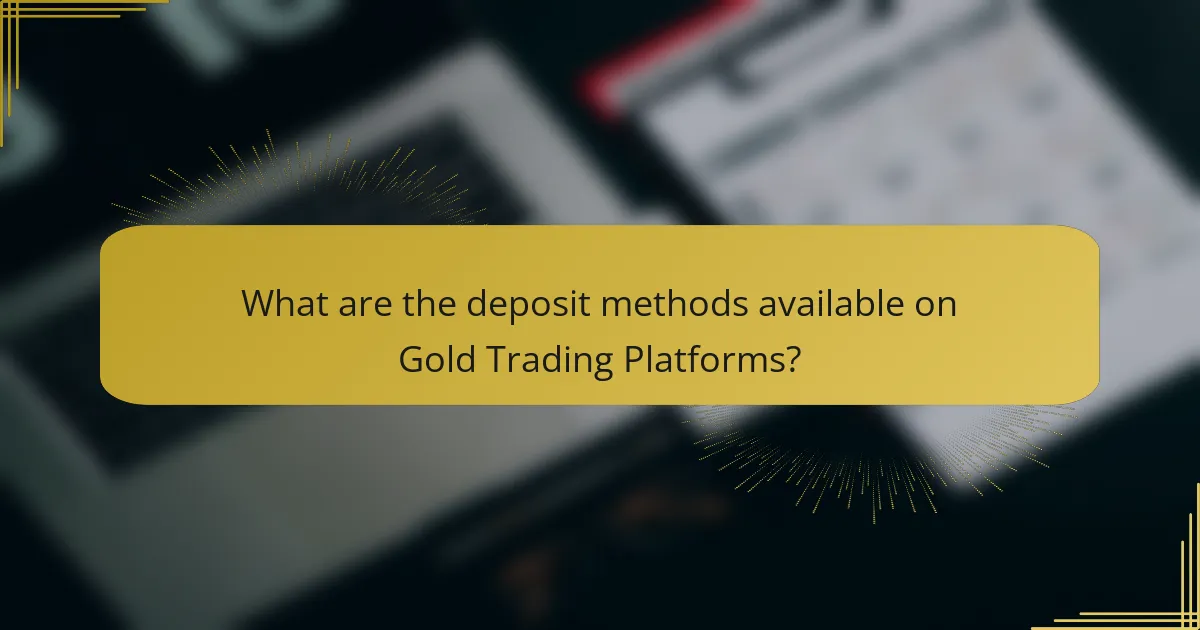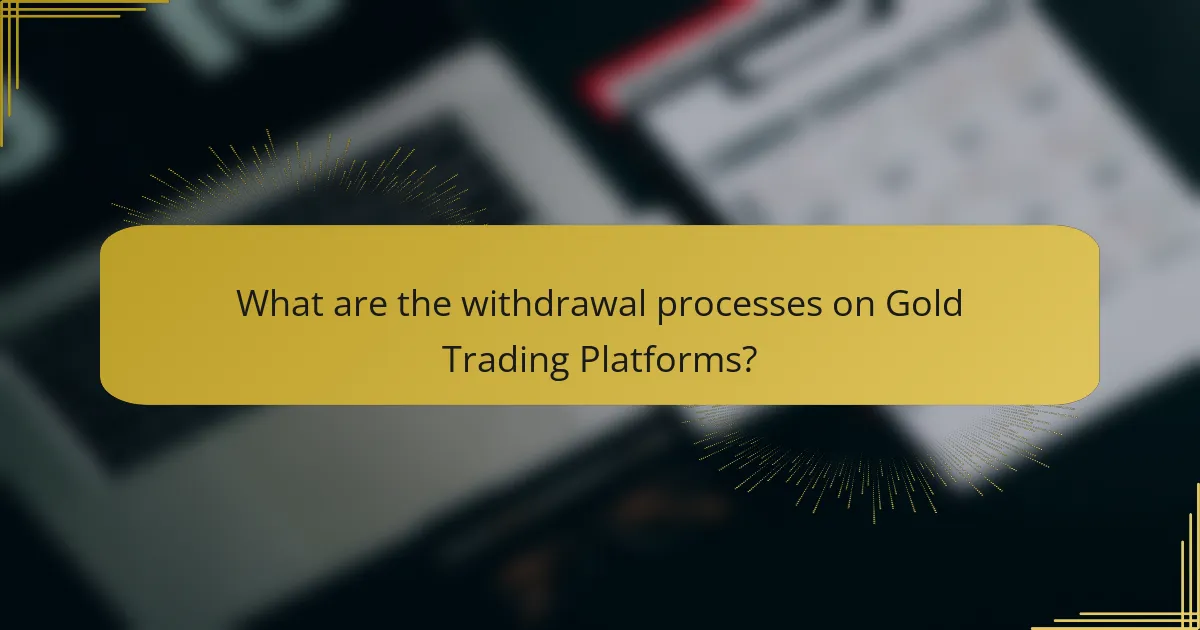Gold trading platforms are online services that enable users to buy and sell gold, including physical gold, gold ETFs, and gold futures. This guide covers essential aspects of using these platforms, including the account setup process, various deposit methods, and withdrawal procedures. Users will learn how to create accounts, fund them through secure payment options like bank transfers and e-wallets, and navigate the withdrawal process efficiently. Key features such as security measures, transaction fees, and real-time market data are also discussed, providing a comprehensive overview for potential gold traders.

What are Gold Trading Platforms?
Gold trading platforms are online services that facilitate the buying and selling of gold. These platforms allow users to trade physical gold, gold ETFs, or gold futures. They typically offer various tools for analysis and trading execution. Users can create accounts to manage their gold investments. Many platforms provide real-time market data and price charts. Security features are essential for protecting user assets. Popular examples include BullionVault and GoldMoney. These platforms often charge fees for transactions and storage.
How do Gold Trading Platforms operate?
Gold trading platforms operate as digital marketplaces for buying and selling gold. They facilitate transactions between buyers and sellers in real-time. Users create accounts to access these platforms. Once registered, users can deposit funds to trade gold. The platforms provide tools for market analysis and price tracking. Transactions occur based on current market prices. Many platforms charge fees or commissions on trades. Security measures protect users’ personal and financial information.
What features are common in Gold Trading Platforms?
Gold trading platforms commonly feature real-time market data. This allows traders to make informed decisions based on current prices. User-friendly interfaces are also standard. They facilitate easy navigation and trading for both beginners and experienced traders.
Security measures, such as two-factor authentication, are essential. These protect user accounts from unauthorized access. Many platforms offer various trading tools. These tools include charts, technical indicators, and analysis features.
Mobile compatibility is increasingly common. This allows users to trade on the go using their smartphones or tablets. Additionally, customer support is usually available through multiple channels. This ensures traders can receive assistance when needed.
Lastly, educational resources are often provided. These resources help users understand market dynamics and improve their trading skills.
How do Gold Trading Platforms ensure security?
Gold trading platforms ensure security through multiple measures. They implement encryption technology to protect user data. This technology secures transactions and personal information from unauthorized access. Many platforms also utilize two-factor authentication for account verification. This adds an extra layer of security during login attempts. Regular security audits are conducted to identify vulnerabilities. Compliance with financial regulations further enhances their security protocols. These measures collectively build trust among users in the gold trading ecosystem.
Why should you consider using Gold Trading Platforms?
Gold trading platforms offer a convenient way to invest in gold. They provide access to real-time market data and trading tools. Users can easily buy and sell gold at competitive prices. Many platforms offer low fees compared to traditional brokers. Gold trading platforms also allow for portfolio diversification. This can help mitigate risks associated with market volatility. Additionally, they often provide educational resources for new investors. According to a report by the World Gold Council, gold has historically been a hedge against inflation.
What are the advantages of trading gold online?
Trading gold online offers several advantages. It provides accessibility to a global market 24/7. Traders can execute transactions at any time without geographical limitations. Online platforms often have lower fees compared to traditional brokers. This can significantly enhance profit margins for traders.
Additionally, online trading allows for real-time price tracking. Traders can make informed decisions quickly based on market trends. Many platforms offer advanced tools and resources for analysis. This can improve trading strategies and outcomes.
Furthermore, online gold trading often includes leverage options. This allows traders to control larger positions with a smaller amount of capital. Overall, these factors contribute to a more efficient and potentially profitable trading experience.
How do Gold Trading Platforms compare to traditional trading methods?
Gold trading platforms offer greater accessibility and convenience compared to traditional trading methods. Users can trade gold 24/7 from anywhere with an internet connection. Traditional methods often require physical presence at a trading location and limited hours of operation.
Gold trading platforms typically feature lower transaction costs due to reduced overhead. Traditional methods might involve higher fees for brokers or physical storage of gold.
Additionally, gold trading platforms provide real-time data and analytics tools. This allows traders to make informed decisions quickly. Traditional methods may lack such immediate access to market information.
Security features on gold trading platforms, such as encryption and two-factor authentication, enhance user safety. Traditional methods may not offer the same level of technological security.
Overall, gold trading platforms present a modern, efficient alternative to traditional trading methods, appealing to a wider range of investors.

How do you set up an account on a Gold Trading Platform?
To set up an account on a Gold Trading Platform, visit the platform’s website. Click on the “Sign Up” or “Register” button. Fill in the required personal information, such as name, email, and phone number. Create a secure password for your account. Verify your email address through the link sent to your inbox. Complete any identity verification process, which may require uploading documents like an ID or proof of address. Once verified, log in to your account. You can then fund your account and start trading. These steps are standard across most gold trading platforms.
What steps are involved in the account registration process?
The account registration process typically involves several key steps. First, users must visit the trading platform’s website. Next, they need to locate and click on the “Sign Up” or “Register” button. Following this, users will be prompted to provide personal information such as name, email address, and phone number. After entering this information, users must create a secure password. Once the information is submitted, users may need to verify their email or phone number through a confirmation link or code. Finally, users may be required to complete additional identity verification steps, such as uploading identification documents. These steps ensure the security and legitimacy of the account.
What personal information is required during registration?
During registration, personal information typically required includes full name, email address, and phone number. Additionally, users may need to provide a residential address and date of birth. Some platforms may request identification documents for verification. This information helps ensure compliance with legal regulations and secure account setup.
How can you verify your identity on the platform?
To verify your identity on the platform, you typically need to provide personal information and documentation. Most platforms require a government-issued ID, such as a passport or driver’s license. You may also need to submit a utility bill or bank statement for address verification.
This process ensures compliance with Know Your Customer (KYC) regulations. KYC is a standard procedure in financial services to prevent fraud and money laundering. After submitting your documents, the platform will review them. Verification can take anywhere from a few minutes to several days, depending on the platform’s policies.
What types of accounts can you open on Gold Trading Platforms?
You can open several types of accounts on gold trading platforms. These typically include standard trading accounts, demo accounts, and managed accounts.
Standard trading accounts allow users to trade gold directly with real funds. Demo accounts provide a risk-free environment for practice trading without real money. Managed accounts involve professional management of trading activities by experienced traders.
Each account type caters to different trading needs and experience levels. Standard accounts are common for active traders. Demo accounts are ideal for beginners to learn the market. Managed accounts suit those who prefer a hands-off approach.
What are the differences between demo and live accounts?
Demo accounts are simulated trading environments, while live accounts involve real money transactions. Demo accounts allow users to practice trading without financial risk. They provide access to the same trading platform features as live accounts. However, demo accounts use virtual currency instead of actual funds. Live accounts require a deposit of real money to trade. The performance in demo accounts may not reflect real market conditions. Emotional factors, such as fear and greed, do not influence demo trading. In contrast, live trading involves real stakes and emotional responses.
How do account types affect trading experience?
Account types significantly affect the trading experience by influencing fees, access to features, and available leverage. Different account types, such as standard, premium, or demo, cater to various trader needs. Standard accounts often have lower fees but limited features. Premium accounts usually offer advanced tools and lower spreads, enhancing trading efficiency. Demo accounts provide a risk-free environment for practice, allowing traders to develop strategies without financial exposure. Research shows that traders using premium accounts often report higher satisfaction due to better support and resources. Thus, the choice of account type directly impacts trading performance and overall satisfaction.

What are the deposit methods available on Gold Trading Platforms?
Gold trading platforms typically offer several deposit methods. Common methods include bank transfers, credit and debit cards, and e-wallets. Bank transfers are secure but may take several days to process. Credit and debit cards provide instant deposits but may incur fees. E-wallets like PayPal and Skrill offer quick transactions and added convenience. Some platforms also accept cryptocurrencies for deposits. Each method varies in processing time and fees, allowing users to choose based on their preferences.
How do you fund your account on a Gold Trading Platform?
To fund your account on a Gold Trading Platform, you typically use bank transfers, credit or debit cards, or e-wallets. Most platforms support direct bank transfers for secure deposits. Credit and debit cards provide quick funding options. E-wallets like PayPal or Skrill are also commonly accepted. Each method may have different processing times. Bank transfers can take several days, while card payments are usually instant. Always check the platform’s specific funding options and fees. This ensures you choose the best method for your needs.
What payment methods are commonly accepted?
Commonly accepted payment methods include credit cards, debit cards, bank transfers, and e-wallets. Credit cards are widely used for their convenience and speed. Debit cards allow direct access to funds from a bank account. Bank transfers provide a secure way to move larger sums. E-wallets like PayPal and Skrill offer quick transactions and added security. These methods are prevalent across various gold trading platforms, ensuring flexibility for users.
How long does it take for deposits to be processed?
Deposits typically take 1 to 5 business days to be processed. The exact duration depends on the deposit method used. Bank transfers may take longer compared to credit or debit card deposits. Electronic wallets usually process deposits faster, often within hours. Factors like the financial institution and transaction volume can also affect processing times.
What fees should you be aware of when depositing funds?
When depositing funds, you should be aware of transaction fees, processing fees, and currency conversion fees. Transaction fees are charged by the payment processor for each deposit. Processing fees may be applied by the trading platform for handling the deposit. Currency conversion fees occur when depositing in a different currency than the account’s base currency. These fees vary by platform and payment method. For example, credit card deposits often incur higher fees compared to bank transfers. Always check the fee schedule of your chosen trading platform for specific amounts. Understanding these fees helps avoid unexpected costs during the deposit process.
Are there minimum deposit requirements on Gold Trading Platforms?
Yes, there are minimum deposit requirements on gold trading platforms. These requirements vary by platform. Some platforms may require as little as $100 to open an account. Others might set minimums at $500 or more. The specific amount often depends on the type of account and services offered. For instance, premium accounts may have higher minimum deposit requirements. Always check the platform’s terms before proceeding. This ensures you meet the necessary criteria for account setup.
How can you avoid unnecessary deposit fees?
To avoid unnecessary deposit fees, choose a trading platform that offers free deposits. Many platforms provide fee-free options for bank transfers or specific payment methods. Research the deposit policies of various platforms before opening an account. Some platforms waive fees for larger deposits or for specific payment methods like ACH transfers. Additionally, consider using e-wallets that may offer lower fees. Review promotional offers that might include fee waivers for new users. Always read the fine print regarding fees associated with deposits. This approach can help you minimize or eliminate deposit costs.

What are the withdrawal processes on Gold Trading Platforms?
Withdrawal processes on gold trading platforms typically involve several steps. Users must first log into their trading account. Then, they navigate to the withdrawal section of the platform. Most platforms require users to select a withdrawal method. Common methods include bank transfers, credit cards, and e-wallets. Users must enter the amount they wish to withdraw. Some platforms may require additional verification for security purposes. Processing times vary by method, ranging from instant to several business days. For instance, bank transfers may take longer than e-wallet withdrawals.
How do you withdraw funds from a Gold Trading Platform?
To withdraw funds from a Gold Trading Platform, access your account and navigate to the withdrawal section. Select your preferred withdrawal method, which could include bank transfer, credit card, or other options. Enter the amount you wish to withdraw and confirm the transaction. The platform will process your request, which may take several business days, depending on the method chosen. Most platforms require verification steps to ensure security before processing withdrawals. Users should check for any fees associated with the withdrawal method. Following these steps ensures a smooth withdrawal process.
What withdrawal methods are typically offered?
Withdrawal methods typically offered include bank transfers, credit and debit cards, and e-wallets. Bank transfers allow direct deposits to a user’s bank account. Credit and debit cards facilitate quick withdrawals back to the card used for deposits. E-wallets, such as PayPal or Skrill, provide instant access to funds. Each method may have different processing times and fees. For example, bank transfers may take several business days, while e-wallets often process instantly. These options cater to varying user preferences and needs in gold trading platforms.
How long does it take for withdrawals to be completed?
Withdrawal completion typically takes between 1 to 5 business days. The exact duration depends on the specific gold trading platform used. Factors influencing withdrawal time include the platform’s processing speed and the chosen withdrawal method. For instance, bank transfers may take longer than e-wallet transactions. Some platforms may also require additional verification steps, which can extend the withdrawal timeframe. Users should check their platform’s policies for precise timelines.
What should you know about withdrawal fees and limits?
Withdrawal fees are charges applied when withdrawing funds from a trading platform. These fees vary by platform and can impact overall trading costs. Many platforms have a minimum withdrawal limit, which is the smallest amount you can withdraw at one time. This limit ensures that transactions are economically viable for the platform. Additionally, some platforms may impose maximum withdrawal limits, which restrict the total amount you can withdraw within a specific timeframe. It is essential to review the fee structure and limits outlined in the platform’s terms and conditions. Understanding these details helps traders plan their withdrawals effectively and avoid unexpected costs.
Are there any restrictions on withdrawal amounts?
Yes, there are typically restrictions on withdrawal amounts in gold trading platforms. These restrictions can vary by platform. Common limits include daily, weekly, or monthly withdrawal caps. Some platforms may require a minimum withdrawal amount. Additionally, certain account types may have different withdrawal limits. For example, verified accounts often have higher limits compared to unverified ones. Always check the specific terms and conditions of the platform you are using to understand the exact restrictions.
How can you minimize withdrawal fees?
To minimize withdrawal fees, choose a trading platform that offers low or no fees for withdrawals. Many platforms have specific withdrawal methods that incur lower costs. For example, bank transfers often have lower fees compared to credit card withdrawals. Additionally, consider withdrawing larger amounts less frequently, as some platforms charge fees per transaction. Research and compare the fee structures of different platforms before selecting one. Platforms like Robinhood and Webull advertise zero commission fees on withdrawals. Always check the terms and conditions to avoid unexpected charges.
What are some best practices for using Gold Trading Platforms?
Use reputable gold trading platforms to ensure security and reliability. Research the platform’s regulatory status and user reviews. Verify that it offers competitive fees and spreads. Utilize two-factor authentication for account security. Monitor market trends and news to make informed trading decisions. Start with a demo account to practice strategies without risk. Diversify your investments to manage risk effectively. Regularly review and adjust your trading strategy based on performance.
Gold trading platforms are online services that enable users to buy and sell gold, including physical gold, gold ETFs, and gold futures. This guide covers essential aspects of using these platforms, including account setup procedures, deposit methods, and withdrawal processes. Key features such as security measures, transaction fees, and types of accounts are examined to provide a comprehensive understanding of the gold trading landscape. Additionally, best practices for effective trading and minimizing costs are discussed to enhance user experience and investment strategies.